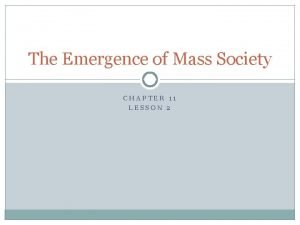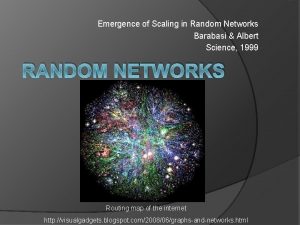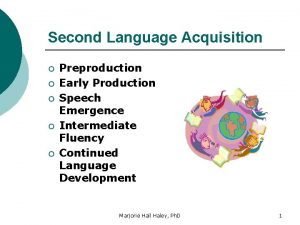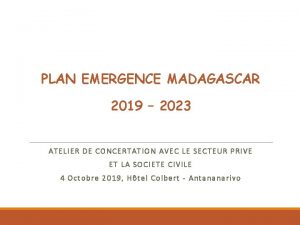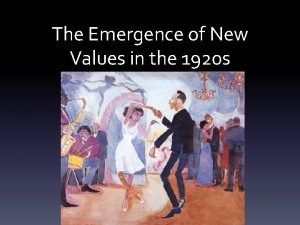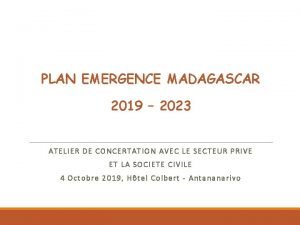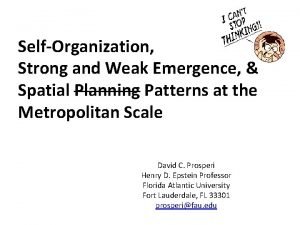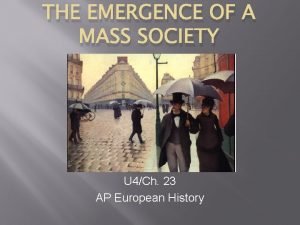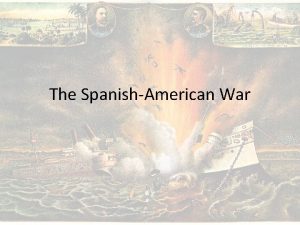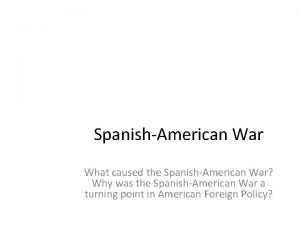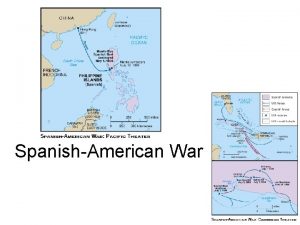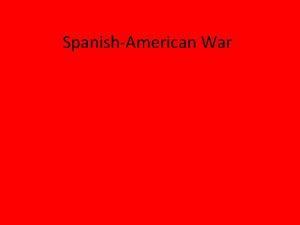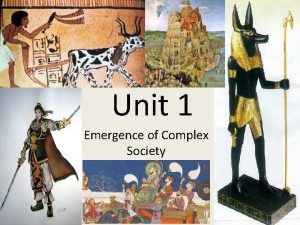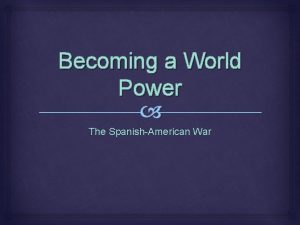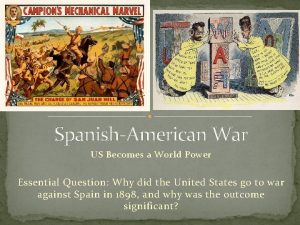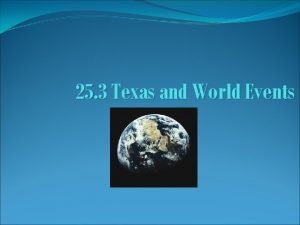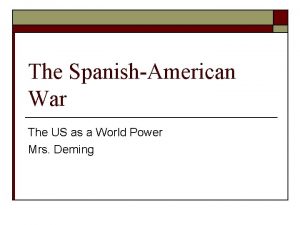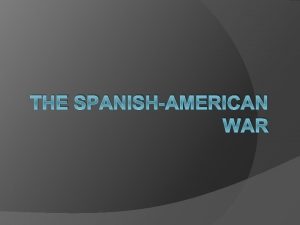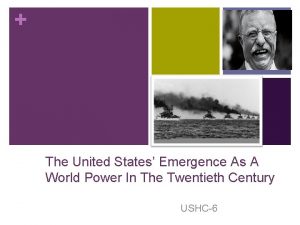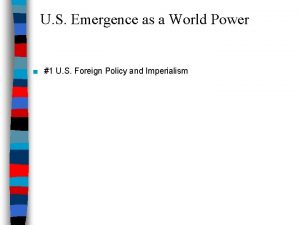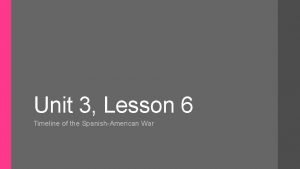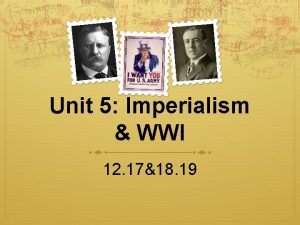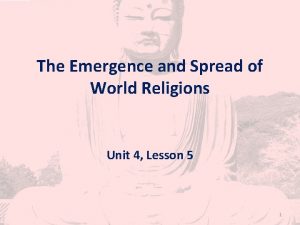Unit 3 Emergence as a World Power SpanishAmerican



















- Slides: 19

Unit 3: Emergence as a World Power Spanish-American and First World Wars 1898 -1920

Emergence as a World Power This era was characterized by the increasing involvement of the United States in World affairs and armed conflicts, including the Spanish American War and the First World War; geographically the nation expanded to control Guam, Hawaii, Philippines, and Puerto Rico; the U. S. became involved in Latin American affairs most notably constructing the Panama Canal

Significant Dates ● 1898 - Spanish-American War ○ ○ United States enters the world stage ending isolationist policy Added territories - Guam, Puerto Rico, Philippines, Cuba ● 1914 -1918: First World War ○ United States joins the Allies in 1917 increasing its role in global affairs

Spanish-American War ● ● ● The U. S. sided with Cubans fighting for independence from Spain. The sinking of the battleship USS Maine in Havana harbor was used by yellow journalists to agitate the American public and pressure President Mc. Kinley into a war with Spain. The United States first attacks Spanish possessions in the Pacific including a devastating blow to Spain’s navy in the Philippines. A U. S. invasion of Cuba culminated in a decisive battle at San Juan Hill and helped then Col. Theodore Roosevelt rise to political prominence. Cuba was liberated and the Philippines, Guam, and Puerto Rico became U. S. territories. The defeat of an old world European power with the use of superior technology and the subsequent acquisition of territory contributed to the rise of the United States as a world power.

U. S. Expansionism ● ● ● Hawaii annexed in 1898 Philippines, Puerto Rico and Guam ceded by Spain in 1898 Some Samoan Islands annexed in 1899 Panama Canal Zone leased in 1904 Virgin Islands purchased from Denmark in 1917 Many islands were opportunities to refuel American naval and trade vessels enabling the U. S. government to project military power further abroad and U. S. business to establish new markets

Significant Individuals ● Henry Cabot Lodge - advocated American expansion as a way to increase national pride, spread civilization, and gain world power; supported intervention in Cuba and annexation of the Philippines ● Alfred Thayer Mahan - naval captain and historian; wrote “The Influence of Seapower on History” published in 1890 that powerfully influenced the development of the U. S. Armed Forces in the early twentieth century and led to an expansion of a modern navy and power across the globe

Significant Individuals (cont’d) ● Theodore Roosevelt - “Rough Rider” during the Spanish- American War; expansionist policies as president increased the role of the U. S. in Latin America and the World; reasserted the Monroe Doctrine in Response to threats of European intervention; reference an African proverb “Speak softly and carry a big stick, you will go far. ” which became known as “big stick” diplomacy; established American involvement in the Panama Canal project ● Sanford B. Dole - contributed to the overthrow of the Hawaiian monarchy; served as the only president of an independent Republic of Hawaii and led efforts for Hawaii annexation to the U. S. after which Mc. Kinley appointed him the first territorial governor ● Missionaries - many missionaries were in China and Hawaii; their work helped link the U. S. with Asia

Foreign Policy ● Open Door Policy - Secretary of State John Hay’s economic policy in China giving the imperial powers equal trading rights in the country (1899 -1900); Boxer Rebellion, U. S. forces suppressed the uprising ● Dollar Diplomacy - Taft encouraged investment by U. S. banks/businesses in Latin America and Far East; promised military protection to those who invested abroad; WWI reoriented the priorities of the emerging world power and U. S. foreign policy makers returned to a goal of isolationism

Panama Canal The Spanish-American War demonstrated the need for faster routes between the East and West coasts of the United States resulting in the building of the Panama Canal, which reduced transportation costs for businesses and the military. Additionally expenditures for the navy increased with overseas expansion ● ● Human factors – The United States supported a revolution in Panama in the early 1900 s and was permitted to build the canal and control a zone of 5 miles on each side of the canal (known as the Canal Zone). President Jimmy Carter signed a treaty to return the Canal area to Panama on December 31, 1999. Physical factors – the 48 -mile international waterway allows ships to pass between the Atlantic Ocean and Pacific Ocean, saving about 8, 000 miles from a journey around the southern tip of South America (Cape Horn).

WWI ● Militarism, alliance systems, imperialism, and nationalism in Europe contributed to the outbreak of the First World War. Political instability in the Balkans, which was characterized by tensions between ethnic groups seeking self-rule culminated in the assassination of the Archduke of Austria-Hungary by a Serbian nationalist. Years of international interference in the Balkans and the system of alliances catapulted a local conflict between the Austro. Hungarian government and the Serbian nationalists into a war which engulfed much of Europe

Reasons for U. S. Entry ● Unrestricted submarine warfare ○ ○ ○ Sussex Pledge – Germany made a pledge not to sink merchant ships without warning and did not uphold this pledge. German submarine torpedoed British ocean liner Lusitania off southern coast of Ireland in May of 1915, resulting in deaths of 128 Americans. Diplomacy failed to call off unrestricted submarine warfare. Germany resumes U-boat attacks on U. S. ships ● Ties to Great Britain ○ The United States conducted a significant amount of trade with Great Britain, which would be affected if Germany won the war ● Interception of the Zimmerman telegram ○ British intelligence decoded the Zimmerman telegram in February of 1917, which revealed Germany’s plan to approach the Mexican government proposing a military alliance. ● The resumption of unrestricted submarine warfare and the interception of the Zimmerman telegram both in February of 1917 contributed to Wilson’s

First World War ● Soon after declaring war on Germany and its allies in 1917. Congress passed the Espionage Act and declared that the U. S. mail could not be used for sending any material that urged “treason, insurrection or forcible resistance to any law. ” It punished offenders with a fine of up to $5, 000 and a five-year prison term ● Participation in the First World War created a need for government revenue which was addressed by the passage of the War Revenue Act adopted in October of 1917. This legislation increased tax rates and greatly increased tax revenues. Additionally the government issued war bonds to finance the war effort. Opportunities for employment increased as war industries demanded labor

WWI Gadgets ● ● ● Machine guns – relatively new technology at the beginning of the war; many difficulties with keeping machine cool, but application had the effect of making it difficult or nearly impossible to cross defended ground which resulted in huge numbers of casualties Airplanes – early in the war used as spotters; planes were unarmed but pilots would carry handheld weapons; later, larger planes were created and were able to bomb the enemy Tanks – developed out of the need to end the stalemate on the western front; early tanks were not reliable, but effective in ending trench warfare by leading infantry charges across “no man’s land” Poison gas – chlorine gas and mustard gas used; sometimes used to create a smoke screen to hide attacking soldiers; also used to force evacuation of enemy trenches Trench warfare that resulted in the stalemate on the western front – form of warfare in which combatants occupy fighting lines, comprised of trenches. While in the trenches, there is little risk of small arms fire, and troops are protected from artillery. The area between opposing trench lines was known as “no man’s land. ”

U. S. Involvement ● U. S. policy of isolationism and neutrality kept the United States out of the war for years. The United States, reluctantly entered the war justified by the idea that U. S. participation would “make the world safe for democracy”establishing a precedent that if the United States went to war it was to spread democracy. ● United States needed to prepare and train a military force. Selective Service Act (1917) was passed requiring young American men to register for the draft. ● Executive power expanded, new agencies such, as War Trade Board, were created to regulate the economy; railroad industry was nationalized

U. S. Involvement (cont’d) ● Taxes increased to pay for the war; sale of war bonds funded war efforts ● Espionage Act of 1917 restricted freedom of speech, specifically related to criticism of the war ● Millions of naturalized American citizens had ties to the nations from which they emigrated, and there was much sympathy for the nations involved in the war. America had strong economic ties to the Allied countries.

Woodrow Wilson’s Fourteen Points ○ ○ ○ President Wilson’s plan to ensure that peace would last; included provisions for the reduction of armaments, freedom of the seas, end to secret alliances, removal of trade barriers, selfdetermination for nation-states, and international cooperation through an international body (the League of Nations). The primary goal of the League of Nations was to provide a forum for countries to resolve their grievances without having to resort to war, thus, helping keep the United States from being led into another war. Opponents in the U. S. Congress, including Henry Cabot Lodge, argued that participation in the League of Nations would pull the United States into unnecessary military commitments and threaten U. S. sovereignty. Many in Congress believed that U. S. involvement in the League of Nations would lead to U. S. involvement in economic and military action without the direct consent of Congress (taking power away from Congress). Ultimately isolationist sentiments prevailed and the Senate refused to ratify the Treaty of Versailles to avoid participation in the League of Nations

Treaty of Versailles ○ French and British leaders seemed more concerned with punishment of Germany, resulting in a treaty that imposed severe sanctions on Germany including reparation payments ○ Established new political boundaries in Europe. Additional treaties divided the Middle East, ended the Austrian-Hungarian Empire and the Ottoman Empire and resulted in increased involvement of British and French in the Middle East and later the United States as allies of the British and French ○ By 1919 American support for isolationism regained popularity after fighting in a war that seemed to have brought little gains for Americans.

Battle of Argonne Forest a part of the final Allied offensive of World War I that stretched along the entire western front, the objective was the capture of an important railroad/train station which would break the railroad net supporting the German Army in France. An Allied victory, the battle is credited for leading to the Armistice

New European Boundaries ● First World War - new political boundaries in Europe were established following the First World War, including Poland, Austria, Hungary, Czechoslovakia, Bulgaria, Estonia, Lithuania, Latvia, and Yugoslavia. Turkey was created in the Anatolian region of the former Ottoman Empire following a war for independence. Parts of the former Ottoman Empire became mandates controlled by the French and British governments, creating the territories of Iraq, Transjordan, Palestine, Lebanon, Syria, Saudi Arabia, Yemen, Qatar, Kuwait, and Bahrain. Germany lost its colonial territories to the League of Nations mandate system.
 Active power reactive power apparent power
Active power reactive power apparent power Emergence theory
Emergence theory The emergence of mass society
The emergence of mass society Ion storm
Ion storm Intermediate fluency stage
Intermediate fluency stage Emergence of scaling in random networks
Emergence of scaling in random networks Preproduction early production speech emergence
Preproduction early production speech emergence Plan emergence madagascar 2019-2023 pdf
Plan emergence madagascar 2019-2023 pdf Netflix core competencies
Netflix core competencies Emergence of entrepreneurial class
Emergence of entrepreneurial class The emergence of new values
The emergence of new values Plan emergence madagascar 2019-2023 pdf
Plan emergence madagascar 2019-2023 pdf Emergence profile
Emergence profile Strong and weak emergence
Strong and weak emergence Landmarks in emergence of corporate governance
Landmarks in emergence of corporate governance Mass society
Mass society Unit 6 review questions
Unit 6 review questions Solar power satellites and microwave power transmission
Solar power satellites and microwave power transmission Actual power
Actual power Flex28024a
Flex28024a


